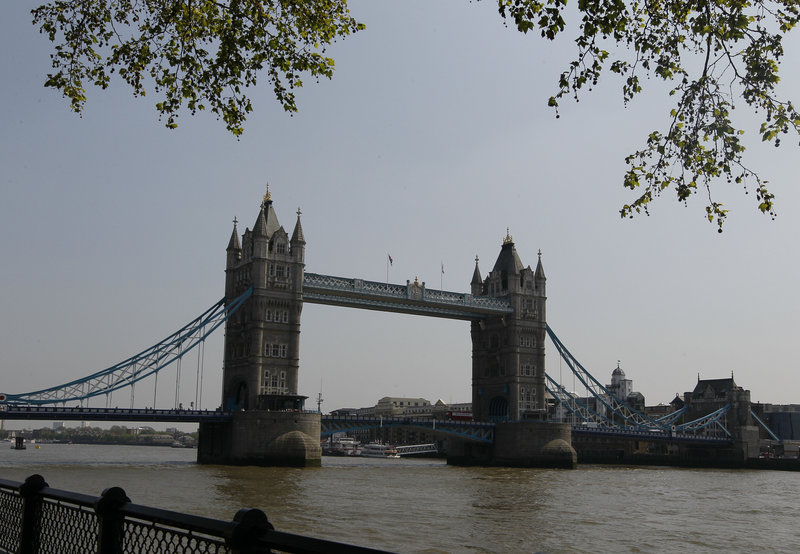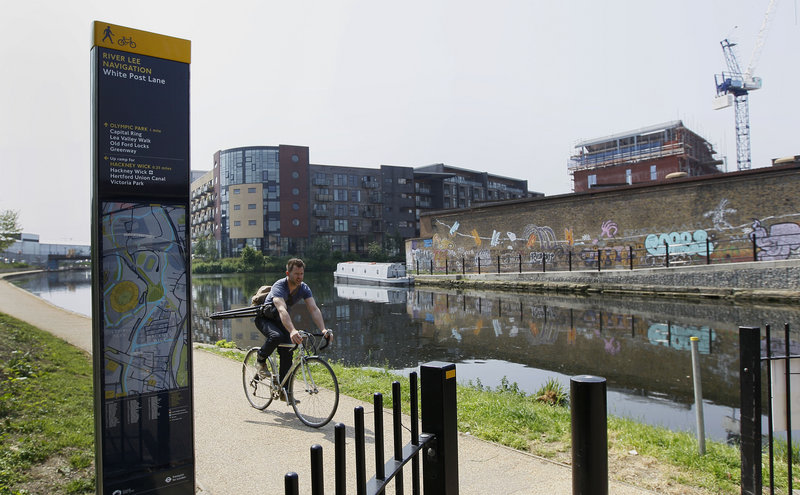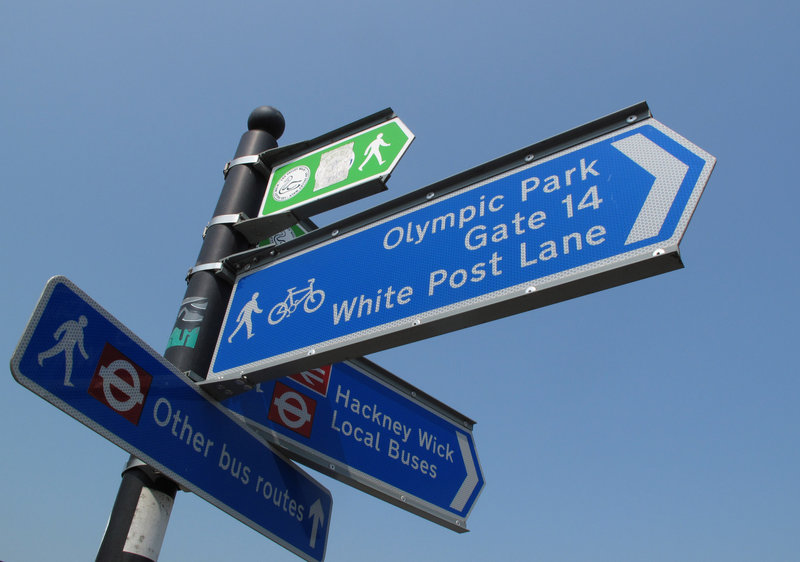LONDON – Like a runner or a swimmer, you would need to be physically fit. Like a goalie or a boxer, you should be prepared for close calls. But if you are coming to London’s Summer Olympics — and you have what it takes — using a bicycle could be a great option in a city bracing for gridlock.
Biking in London is not for the average tourist. The British capital can be a cauldron of trucks, buses, black cabs, cars, motorcycles and bikes competing fiercely with one another, especially on major roads during rush hour.
Still, thousands of locals do commute to work on bicycles each day. One reason is a growing number of bike paths, including some along an ancient canal system that is closed to drivers. The city also rents out thousands of bikes on its streets.
“Riding on London’s main roads is not for the faint of heart,” said Dan Stone, 52, an American who lives in central London and regularly cycles there. “But find out-of-the-way routes and you can see so much more of this amazing city than someone on public transportation.”
London has 15 bicycle maps, including a new one with routes to Olympic Park in eastern London. Tourists who use them to plan their bike rides could find it faster, cheaper and more fun to travel to the many Olympic venues during the July 27-Aug. 12 games than visitors taking cabs, buses, trains and subways. People who carefully plan their journeys to Olympic venues could also stop at major tourist locations en route such as Buckingham Palace, Big Ben, Oxford Street, the New Tate Museum and Victoria Park.
By contrast, tourists who decide to rent cars will have to pay London’s 10-pound-a-day ($16) congestion fee, buy gasoline that costs about $10 a gallon and find some way to avoid 30 miles (48 kilometers) of special road lanes — all the key routes, basically — that will be reserved for the exclusive use of tens of thousands of Olympic athletes, officials, sponsors and reporters. And good luck finding a parking place.
For those taking public transportation, London’s subways, trains and buses are expected to handle 15 million trips a day during the busiest days of the Olympics, up from a daily average of 12 million.
That’s why Olympic organizers are promoting the bike.
A year ago, Mayor Boris Johnson — an avid bike rider — oversaw the creation of the Barclays Cycle Hire program, which has made 8,000 rental cycles available across the city.
For visitors from countries such as the United States, the important thing to remember is which side of the road to ride on — with the traffic, on the left — a key point in a city where an average of 17 bike riders die each year in accidents.
Many of London’s bike paths only separate cyclists from drivers with a line painted in the road — one that can suddenly end at intersections and busy roundabouts. Some bike paths are separated from the road by a curb, and others follow the city’s extensive canal network, which is only open to cyclists and walkers.
But even the canal system can be a challenge for inexperienced bike riders. There are no barriers on the narrow paths to prevent riders from falling into the water, the surfaces on the paths include dirt and wobbly concrete blocks, and some of the bridges to pass under are so low bikers have to duck their heads.
In some ways, a bike riding novice in London is like a beginning skier in the Alps, according to Lilli Matson, an official with Transport of London — they need to be careful. She suggests newcomers practice riding in safe zones such as London’s Hyde Park.
“It’s a great option,” she said of bike riding through London, which she does every day. “But look at the Web sites for the rules of the road and the precautions to take, especially if you are coming from a different country.”
One option for tourists is to rent the “Boris Bikes” — as the Barclays cycles are now known. They can be picked up at one docking station and dropped off at another. Short rides are cheap, but the price goes up quickly after that. No one can guarantee there will be a bike available at each docking station or that there will be an empty slot to drop one off when you are finished. Also, there won’t be docking stations near all the Olympic venues in London. A better option may be to rent your own bike and ride the city without having to watch the clock. People who bike to Olympic Park will find 7,000 spaces to safely lock up their wheels.
Many of the eight bike routes to Olympic Park are 4 to 5 miles long (6.5 to 8 kilometers), and the ones that follow the canal system take visitors past houseboats, pubs, parks and reservoirs in areas that have graffiti-covered walls, swanky apartments and everything in between.
One route to the Olympic Park starts at the Tower of London on north side of the Thames River. It passes by historic port pubs such as The Prospect of Whitby — once home to sailors, smugglers and cutthroats. The path then goes through Shadwell Basin, where expensive apartments designed like dockside warehouses sit on the water’s edge.
Visitors on bikes will able to explore the capital street by street, including East London, a region that tourists often miss. For many years, East London was the epitome of poverty, crime, immigration, crammed public housing and Port of London docks on the Thames. During World War II, Luftwaffe bombers pulverized the area.
Today, many young Brits consider East Side areas such as Hackney, Shoreditch, Hoxton and Wopping as hipper and more diverse than west London, which has traditional tourist sites like the London Eye, Trafalgar Square, Parliament and the theater district.
One of the goals of the Olympics has been to extend the East Side’s gentrification.
“Much of the East Side of London retains the feel of a 19th-century industrial center,” said Stone. “The buildings, street names, even some of the surviving businesses, evoke a London of a different age. And now the area is peppered with pockets of intensely cool design and technology.”
As the Olympic Games approach, the organizers are rushing to install all the signs that out-of-town bikers will need to navigate the trails. But in this sprawling metropolis, where self-defense for bike riders is a must, there also is a sense of camaraderie among cyclists.
When I got lost recently navigating a maze of narrow streets and paths near the Thames during evening rush hour, a fellow rider stopped, turned around and led me back to a route I knew in East London.
“Cheers,” he said, and before I could thank him, he was gone.
Send questions/comments to the editors.





Success. Please wait for the page to reload. If the page does not reload within 5 seconds, please refresh the page.
Enter your email and password to access comments.
Hi, to comment on stories you must . This profile is in addition to your subscription and website login.
Already have a commenting profile? .
Invalid username/password.
Please check your email to confirm and complete your registration.
Only subscribers are eligible to post comments. Please subscribe or login first for digital access. Here’s why.
Use the form below to reset your password. When you've submitted your account email, we will send an email with a reset code.